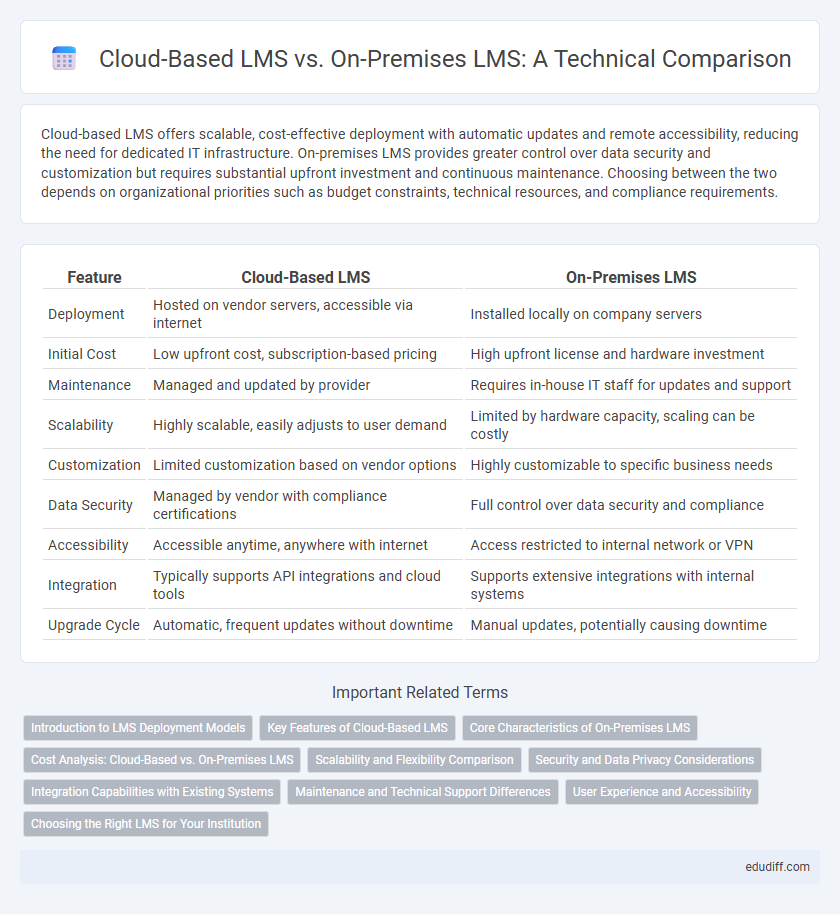Cloud-based LMS offers scalable, cost-effective deployment with automatic updates and remote accessibility, reducing the need for dedicated IT infrastructure. On-premises LMS provides greater control over data security and customization but requires substantial upfront investment and continuous maintenance. Choosing between the two depends on organizational priorities such as budget constraints, technical resources, and compliance requirements.
Table of Comparison
| Feature | Cloud-Based LMS | On-Premises LMS |
|---|---|---|
| Deployment | Hosted on vendor servers, accessible via internet | Installed locally on company servers |
| Initial Cost | Low upfront cost, subscription-based pricing | High upfront license and hardware investment |
| Maintenance | Managed and updated by provider | Requires in-house IT staff for updates and support |
| Scalability | Highly scalable, easily adjusts to user demand | Limited by hardware capacity, scaling can be costly |
| Customization | Limited customization based on vendor options | Highly customizable to specific business needs |
| Data Security | Managed by vendor with compliance certifications | Full control over data security and compliance |
| Accessibility | Accessible anytime, anywhere with internet | Access restricted to internal network or VPN |
| Integration | Typically supports API integrations and cloud tools | Supports extensive integrations with internal systems |
| Upgrade Cycle | Automatic, frequent updates without downtime | Manual updates, potentially causing downtime |
Introduction to LMS Deployment Models
Cloud-based LMS deployment offers scalable, remote access to learning management systems hosted on third-party servers, reducing the need for internal IT infrastructure. On-premises LMS installations provide organizations with full control over data security and customization by hosting the software on local servers. Selecting the appropriate deployment model depends on factors such as budget, compliance requirements, and desired flexibility.
Key Features of Cloud-Based LMS
Cloud-based LMS platforms offer seamless scalability, enabling organizations to adjust user capacity without hardware constraints. These systems provide automatic updates and maintenance, ensuring access to the latest features and security patches without manual intervention. Robust remote accessibility guarantees that learners and administrators can engage with the platform anytime and anywhere via web browsers or mobile devices.
Core Characteristics of On-Premises LMS
On-premises LMS solutions provide organizations with complete control over their data and customization options, as the software is installed locally on internal servers. They require significant upfront investment in hardware and IT infrastructure, alongside ongoing maintenance and support managed by in-house teams. Enhanced security measures and compliance adherence are ensured through direct management of the LMS environment, making it suitable for organizations with strict regulatory requirements.
Cost Analysis: Cloud-Based vs. On-Premises LMS
Cloud-based LMS typically offers lower upfront costs by eliminating the need for physical infrastructure and reducing IT maintenance expenses, making it an attractive option for organizations with limited budgets. On-premises LMS requires significant capital expenditure for hardware, licensing, and ongoing system management, which can increase total cost of ownership over time. Scalability and subscription-based pricing models in cloud LMS further optimize operational costs compared to fixed investment in on-premises solutions.
Scalability and Flexibility Comparison
Cloud-based LMS platforms offer superior scalability by enabling seamless resource allocation and user capacity expansion without hardware constraints, adapting to fluctuating organizational needs efficiently. On-premises LMS require significant upfront infrastructure investment and manual upgrades, limiting flexibility in scaling operations quickly. Elastic cloud architectures support faster deployment of updates and integrations, enhancing overall system agility compared to the fixed infrastructure of on-premises solutions.
Security and Data Privacy Considerations
Cloud-based LMS platforms offer enhanced security measures such as end-to-end encryption, multi-factor authentication, and continuous monitoring by dedicated security teams, reducing the risk of data breaches. On-premises LMS solutions provide organizations with full control over data storage and privacy policies, enabling compliance with strict regulatory requirements but requiring significant internal resources for maintenance and security updates. Data privacy concerns in cloud LMS revolve around third-party access and data residency, whereas on-premises LMS demands robust internal protocols to safeguard sensitive information.
Integration Capabilities with Existing Systems
Cloud-based LMS platforms offer superior integration capabilities through APIs and web services, enabling seamless connectivity with CRM, HRIS, and ERP systems for real-time data synchronization and streamlined workflows. On-premises LMS solutions often require custom development and middleware to connect with legacy systems, leading to increased complexity and longer deployment times. Enterprises prioritizing agility and scalable integrations benefit from cloud-based LMS for efficient interoperability and reduced IT overhead.
Maintenance and Technical Support Differences
Cloud-based LMS platforms offer automatic software updates, patch management, and 24/7 vendor support, reducing the need for in-house IT resources and minimizing downtime. In contrast, on-premises LMS solutions require dedicated internal teams for regular maintenance, hardware upkeep, and manual updates, increasing operational complexity and costs. Cloud-based systems streamline technical support through centralized administration, whereas on-premises environments demand more extensive technical expertise and time investment for troubleshooting and system upgrades.
User Experience and Accessibility
Cloud-based LMS platforms provide seamless access across devices and locations through internet connectivity, enhancing user experience with real-time updates and collaborative tools. On-premises LMS may offer faster performance and customization options but often limit accessibility due to device and network constraints. User interface design in cloud-based LMS is optimized for intuitive navigation and scalability, ensuring consistent learning experiences for diverse user groups.
Choosing the Right LMS for Your Institution
Cloud-based LMS platforms offer scalable storage, seamless updates, and remote accessibility, making them ideal for institutions with distributed learners and limited IT staff. On-premises LMS solutions provide enhanced control over data security and customization, suitable for organizations with stringent compliance requirements and existing infrastructure. Evaluating factors such as budget, IT resources, user needs, and long-term scalability is crucial when selecting the optimal LMS for your institution.
Cloud-Based LMS vs On-Premises LMS Infographic

 edudiff.com
edudiff.com